Description
THERAPEUTIC CLASS:
Losapott (Losartan potassium), the first of a new class of agents for the treatment of hypertension, is an angiotensin II receptor (type AT1) antagonist. Losapott also provides a reduction in the combined risk of cardiovascular death, stroke, and myocardial infarction in hypertensive patients with left ventricular hypertrophy and renal protection for type 2 diabetic patients with proteinuria.
THERAPEUTIC INDICATIONS:
• Treatment of essential hypertension in adults and in children and adolescents 6-18 years of age.
• Treatment of renal disease in adult patients with hypertension and type 2 diabetes mellitus with proteinuria 0.5 g/day as part of an antihypertensive treatment.
• Treatment of chronic heart failure (in patients 60 years), when treatment with Angiotensin converting enzyme (ACE) inhibitors is not considered suitable due to incompatibility, especially cough, or contraindication. Patients with heart failure who have been stabilised with an ACE inhibitor should not be switched to losapott. The patients should have a left ventricular ejection fraction 40% and should be clinically stable and on an established treatment regimen for chronic heart failure.
• Reduction in the risk of stroke in adult hypertensive patients with left ventricular hypertrophy documented by ECG.
POSOLOGY AND METHOD OF ADMINISTRATION: Losapott tablets should be swallowed with a glass of water. Losapott may be administered with or without food. Hypertension The usual starting and maintenance dose is 50 mg once daily for most patients. The maximal antihypertensive effect is attained 3-6 weeks after initiation of therapy. Some patients may receive an additional benefit by increasing the dose to 100 mg once daily (in the morning). Losapott may be administered with other antihypertensive agents, especially with diuretics (e.g. hydrochlorothiazide).
Hypertensive type II diabetic patients with proteinuria 0.5 g/day The usual starting dose is 50 mg once daily. The dose may be increased to 100 mg once daily based on blood pressure response from one month onwards after initiation of therapy. Losapott may be administered with other antihypertensive agents (e.g. diuretics, calcium channel blockers, alpha- or beta-blockers, and centrally acting agents) as well as with insulin and other commonly used hypoglycemic agents (e.g.sulfonylureas, glitazones and glucosidase inhibitors).
Heart failure The usual initial dose of losapott in patients with heart failure is 12.5 mg once daily. The dose should generally be titrated at weekly intervals (i.e. 12.5 mg daily, 25 mg daily, 50 mg daily, 100 mg daily, up to a maximum dose of 150 mg once daily) as tolerated by the patient. Reduction in the risk of stroke in hypertensive patients with left ventricular hypertrophy documented by ECG The usual starting dose is 50 mg of losapott once daily. A low dose of hydrochlorothiazide should be added and/ or the dose of losapott should be increased to 100 mg once daily based on blood pressure response.
Special populations Use in patients with intravascular volume depletion: For patients with intravascular volume-depletion (e.g. those treated with high-dose diuretics), a starting dose of 25 mg once daily should be considered. Use in patients with renal impairment and haemodialysis patients: No initial dosage adjustment is necessary in patients with renal impairment and in haemodialysis patients. Use in patients with hepatic impairment: A lower dose should be considered for patients with a history of hepatic impairment. There is no therapeutic experience in patients with severe hepatic impairment. Therefore, losapott is contraindicated in patients with severe hepatic impairment. Paediatric population There are limited data on the efficacy and safety of losapott in children and adolescents aged 6-18 years old for the treatment of hypertension. Limited pharmacokinetic data are available in hypertensive children above one month of age. For patients who can swallow tablets, the recommended dose is 25 mg once daily in patients >20 to <50 kg. (In exceptional cases the dose can be increased to a maximum of 50 mg once daily). Dosage should be adjusted according to blood pressure response. In patients >50 kg, the usual dose is 50 mg once daily. In exceptional cases the dose can be adjusted to a maximum of 100 mg once daily. Doses above 1.4 mg/ kg (or in excess of 100 mg) daily have not been studied in paediatric patients. Losapott is not recommended for use in children under 6 years old, as limited data are available in these patient groups. It is not recommended in children with glomerular filtration rate < 30 ml/ min / 1.73 m2, as no data are available. Losapott is also not recommended in children with hepatic impairment. Use in Elderly Although consideration should be given to initiating therapy with 25 mg in patients over 75 years of age, dosage adjustment is not usually necessary for the elderly.
CONTRAINDICATIONS:
Losapott is contraindicated in patients who are hypertensive to any component of this product.
The concomitant use of Losapott with aliskiren-containing products is contraindicated in patients with diabetes mellitus or renal impairment (GFR<60 ml / min/1.73m2).
SPECIAL WARNINGS AND PRECAUTIONS FOR USE:
Hypersensitivity
Angiooedema: Patients with a history of angiooedema (swelling of the face, lips, throat, and/ or tongue) should be closely monitored.
Hypotension and electrolyte/fluid imbalance
Symptomatic hypotension, especially after the first dose and after increasing of the dose, may occur in patients who are volume and/or sodiumdepleted by vigorous diuretic therapy, dietary salt restriction, diarrhoea or vomiting. These conditions should be corrected prior to administration of losapott, or a lower starting dose should be used. This also applies to children 6 to 18 years of age.
Electrolyte imbalances
-Electrolyte imbalances are common in patients with renal impairment, with or without diabetes, and should be addressed. In type 2 diabetic patients with nephropathy, the incidence of hyperkalemia was higher when treated with losapott. Therefore, the plasma concentrations of potassium as well as creatinine clearance values should be closely monitored, especially patients with heart failure and a creatinine clearance between 3050 ml/ min should be closely monitored.
-The concomitant use of potassium-sparing diuretics, potassium supplements and potassium-containing salt substitutes with losapott is not recommended.
Hepatic impairment
Based on pharmacokinetic data which demonstrate significantly increased plasma concentrations of losapott in cirrhotic patients, a lower dose should be considered for patients with a history of hepatic impairment. There is no therapeutic experience with losapott in patients with severe hepatic impairment. Therefore losapott must not be administered in patients with severe hepatic impairment.
Losapott is not recommended in children with hepatic impairment.
Renal impairment
As a consequence of inhibiting the reninangiotensin system, changes in renal function including renal failure have been reported (in particular, in patients whose renal function is dependent on the renin- angiotensin-aldosterone system such as those with severe cardiac insufficiency or preexisting renal dysfunction). As with other medicinal products that affect the reninangiotensinaldosterone system, increases in blood urea and serum creatinine have also been reported in patients with bilateral renal artery stenosis or stenosis of the artery to a solitary kidney; these changes in renal function may be reversible upon discontinuation of therapy. Losapott should be used with caution in patients with bilateral renal artery stenosis or stenosis of the artery to a solitary kidney.
Use in paediatric patients with renal impairment
Losapott is not recommended in children with glomerular filtration rate < 30 ml/ min/ 1.73 m2 as no data are available.
Renal function should be regularly monitored during treatment with losapott as it may deteriorate. This applies particularly when losapott is given in the presence of other conditions (fever, dehydration) likely to impair renal function.
Concomitant use of losapott and ACEinhibitors has shown to impair renal function. Therefore, concomitant use is not recommended.
Renal transplantation
There is no experience in patients with recent kidney transplantation.
Primary hyperaldosteronism
Patients with primary aldosteronism generally will not respond to antihypertensive medicinal products acting through inhibition of the reninangiotensin system. Therefore, the use of losapott is not recommended.
Coronary heart disease and cerebrovascular disease
As with any antihypertensive agents, excessive blood pressure decrease in patients with ischaemic cardiovascular and cerebrovascular disease could result in a myocardial infarction or stroke.
Heart failure
In patients with heart failure, with or without renal impairment, there is as with other medicinal products acting on the reninangiotensin system a risk of severe arterial hypotension, and (often acute) renal impairment.
There is no sufficient therapeutic experience with losapott in patients with heart failure and concomitant severe renal impairment, in patients with severe heart failure (NYHA class IV) as well as in patients with heart failure and symptomatic life threatening cardiac arrhythmias. Therefore, losapott should be used with caution in these patient groups. The combination of losapott with a betablocker should be used with caution.
Aortic and mitral valve stenosis, obstructive hypertrophic cardiomyopathy
As with other vasodilators, special caution is indicated in patients suffering from aortic or mitral stenosis, or obstructive hypertrophic cardiomyopathy.
Dual blockade of the renin-angiotensin-aldosterone system (RAAS) There is evidence that the concomitant use of ACE-inhibitors, angiotensin II receptor blockers or aliskiren increases the risk of hypotension, hyperkalaemia, and decreased renal function (including acute renal failure). Dual blockade of RAAS through the combined use of ACE-inhibitors, angiotensin II receptor blockers or aliskiren is therefore not recommended. If dual blockade therapy is considered absolutely necessary, this should only occur under specialist supervision and subject to frequent close monitoring of renal function, electrolytes and blood pressure. ACE-inhibitors and angiotensin II receptor blockers should not be used concomitantly in patients with diabetic nephropathy.
Pregnancy
Not to be used during pregnancy because Angiotensin blockers can cause injury and even death to the developing fetus.
Other warnings and precautions
As observed for angiotensin converting enzyme inhibitors, losapott and the other angiotensin antagonists are apparently less effective in lowering blood pressure in black people than in nonblacks, possibly because of higher prevalence of lowrenin states in the black hypertensive population.
♣ This medicinal product contains lactose monohydrate, patients with rare hereditary problems of galactose intolerance, the Lapp lactase deficiency or glucose- galactose malabsorption should not take this medicine.
NURSING MOTHERS:
It is not known whether losapott is excreted in human milk. Because many drugs are excreted in human milk and because of the potential for adverse effects on the nursing infant, a decision should be made whether to discontinue nursing or discontinue the drug, taking into account the importance of the drug to the mother.
Use in the elderly
No age-related difference in the efficacy or safety profile of losapott.
DRUG INTERACTIONS:
No drug interactions of clinical significance have been identified with hydrochlorothiazide, digoxin, warfarin, cimetidine, phenobarbital, ketoconazole, and erythromycin. Rifampin and fluconazole reduce levels of active metabolite
As with other drugs that block angiotensin II or its effects, concomitant use of potassium-sparing diuretics (e.g., spironolactone, triamterene, amiloride), potassium supplements, or salt substitutes containing potassium may lead to increases in serum potassium.
Non-steroidal anti-inflammatory drugs (NSAIDs) including selective cyclooxygenase-2 inhibitors (COX-2 inhibitors) may reduce the effect of diuretics and other antihypertensive drugs. Therefore, the antihypertensive effect of angiotensin II receptor antagonists may be attenuated by NSAIDs including selective COX-2 inhibitors.
In some patients with compromised renal function who are being treated with non-steroidal anti-inflammatory drugs, including selective cyclooxygenase-2 inhibitors, the co-administration of angiotensin II receptor antagonists may result in a further deterioration of renal function. These effects are usually reversible.
UNDESIRABLE EFFECTS:
Hypertension
Nervous system disorders:
Common: dizziness, vertigo
Uncommon: somnolence, headache, sleep disorders
Cardiac disorder:
Uncommon: palpitations, angina pectoris
Vascular disorders:
Uncommon: symptomatic hypotension (especially in patients with intravascular volume depletion, e.g. patients with severe heart failure or under treatment with high dose diuretics), doserelated orthostatic effects, rash.
Gastro-intestinal disorders:
Uncommon: abdominal pain, constipation
General disorders and administration site conditions:
Uncommon: asthenia, fatigue, oedema
Investigations:
Hyperkalemia
Increased alanine aminotransferase (ALT), usually resolved upon discontinuation.
Hypertensive patients with left ventricular hypertrophy
Nervous system disorders:
Common: dizziness
Ear and labyrinth disorders:
Common: vertigo
General disorders and administration site conditions:
Common: asthenia/fatigue
Chronic heart failure
Nervous system disorders:
Uncommon: dizziness, headache
Rare: paraesthesia
Cardiac disorders:
Rare: syncope, atrial fibrillation, cerebrovascular accident
Vascular disorders:
Uncommon: hypotension, including orthostatic hypotension
Respiratory, thoracic and mediastinal disorders:
Uncommon: dyspnoea and cough.
Gastro-intestinal disorders:
Uncommon: diarrhoea, nausea, vomiting
Skin and subcutaneous tissue disorders:
Uncommon: urticaria, pruritus, rash
General disorders and administration site conditions:
Uncommon: asthenia/fatigue
Investigations:
Uncommon: increase in blood urea, serum creatinine and serum potassium and hyperkalemia.
Renal and urinary disorders:
Common: renal failure, renal impairment.
Hypertension and type 2 diabetes with renal disease
Nervous system disorders:
Common: dizziness
Vascular disorders:
Common: hypotension
General disorders and administration site conditions:
Common: asthenia/fatigue
Investigations:
Common: hypoglycaemia, hyperkalemia
Blood and lymphatic system disorders:
Not known: anemia
Cardiac disorders:
Not known: syncope, palpitations
Vascular disorders:
Not known: orthostatic hypotension
Gastro-intestinal disorders:
Not known: diarrhoea
Musculoskeletal and connective tissue disorders:
Not known: back pain
Renal and urinary disorders:
Not known: urinary tract infections
General disorders and administration site conditions:
Not known: flulike symptoms
Blood and lymphatic system disorders:
Not known: anemia, thrombocytopenia
Ear and labyrinth disorders:
Not known: tinnitus
Immune system disorders:
Rare: hypersensitivity: anaphylactic reactions, angio-oedema including swelling of the larynx and glottis causing airway obstruction and/or swelling of the face, lips, pharynx, and/or tongue; in some of these patients angio-oedema had been reported in the past in connection with the administration of other medicines, including ACE inhibitors; vasculitis, including HenochSchonlein purpura.
Nervous system disorders:
Not known: migraine
Respiratory, thoracic and mediastinal disorders:
Not known: cough
Gastro-intestinal disorders:
Not known: diarrhoea, pancreatitis
General disorders and administration site conditions:
Not known: malaise
Hepatobiliary disorders:
Rare: hepatitis
Not known: liver function abnormalities
Skin and subcutaneous tissue disorders:
Not known: urticaria, pruritus, rash, photosensitivity
Musculoskeletal and connective tissue disorders:
Not known: myalgia, arthralgia, rhabdomyolysis
Reproductive system and breast disorders:
Not known: erectile dysfunction/impotence
Renal and urinary disorders:
As a consequence of inhibiting the reninangiotensinaldosterone system, changes in renal function including renal failure have been reported in patients at risk; these changes in renal function may be reversible upon discontinuation of therapy.
Psychiatric disorders:
Not known: depression
Investigations:
Not known: hyponatraemia
Paediatric population
The adverse reaction profile for paediatric patients appears to be similar to that seen in adult patients. Data in the paediatric population are limited.
OVERDOSAGE:
Limited data are available in regard to overdosage in humans. The most likely manifestation of overdosage would be hypotension and tachycardia; bradycardia could occur from parasympathetic (vagal) stimulation. If symptomatic hypotension should occur, supportive treatment should be instituted.
STORAGE
Keep at a temperature not exceeding 30C, in dry place.
Keep out of reach of children.
PACKAGE
A carton box containing 14 tablets in 2 PVC/Al strips with a pamphlet.
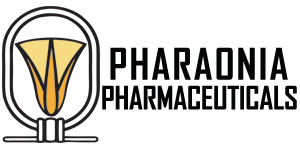

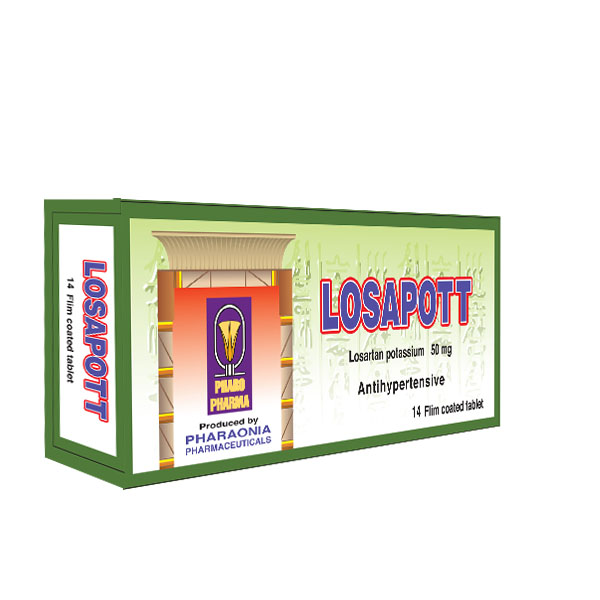
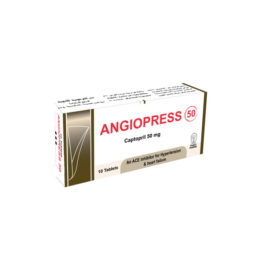
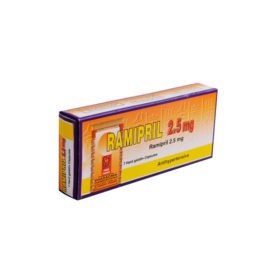
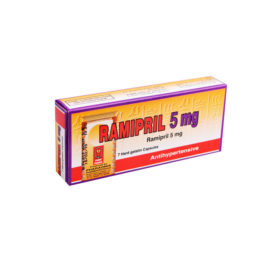
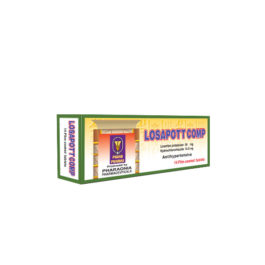

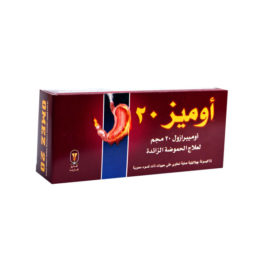
Reviews
There are no reviews yet.